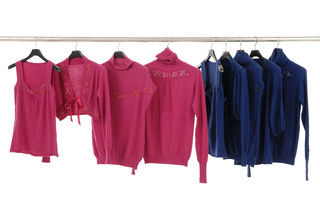Media
Social Media Apps for Green Fashion
Some apps and sites are using social media to encourage us to reuse clothing.
Posted August 22, 2018

Not a Fashionista
Today I’m writing about something fairly far afield from my usual concerns: Fashion and social media. Professors are not uniformly known for our fashion sense. If I asked you what a professor wears, you might conjure up an image of plaid blazers with elbow pads, which, by the way, is cool with me.
I do think I haven’t taken the train too far from the station here, given that I’m going to talk about everyday people using social media in the realm of “wearables” in the old-fashioned sense (a.k.a. “clothing”). After all, we all need to get dressed, and everyone has a budget. Social media have made it possible to do some interesting things for this experience of finding and buying clothes.
On Minimalism and Reusing
A while back, there was a showing of the film Minimalism in my home town, which I attended. Minimalism is basically the philosophy of considering how many things you need and how many things you produce and add to the planet. In a memorable part of the film, the audience sees typical American clothing stores and how many garments are made and sold each day. Seeing the volume made me think.
I read a statistic online recently that said that women do not wear 70% of what’s in their closets. I’m sure, like anything, it depends on who you ask, but most of us realize that we have our favorites and that our closets are full of things we only occasionally glance at and never wear. Enter social media.
There are a number of apps and sites that use media as a pivotal point of the business. Maybe you can name more than I can, but I’m going to share with you a few that I’m experienced with.
Poshmark is one site whose business is to resell clothing and related items. Poshmark is basically a social media consignment shop. How it works is a lot like EBay for fashion. Basically, anyone can be a seller and/or a buyer. Take pictures of that nice sweater that is not your color, post it online and it goes to the app as well. Buyers can make you an offer. Once you agree on a price, the company sends you a shipping label. You pay for shipping and ship the item to the buyer.
Inside the app and site, you can post your picture, post your clothes for sale, and send and receive social media messages about your items. You can talk in public about the items, or you can talk directly to people who are interested, via private message. Like Facebook, there are “likes” and “shares.”
Recently, I posted my briefcase on Poshmark. It was a peacock-colored briefcase I bought at the University of Missouri bookstore (go Tigers!). I loved this bag, but it was too big for my needs. I sold it, and turned around and bought a similar bag of the same brand, the same color, even the same polka dotted lining, but this bag was smaller. The perfect size for my needs! I used the proceeds from selling my first laptop bag to buy the new one. It was a win-win. My poor, lonely laptop bag could stop gathering dust at the back of my closet; someone new could love it. And I got the exact same bag, but (magically) minimalized to meet my needs.
ThredUP is another online thrift/consignment shop. I must admit that I am rather addicted to this one. The concept is similar to Poshmark. However, on ThredUp, they go through the clothes themselves and select the ones they think are in the best shape and meet their standards. Then they keep the clothes and ship them to the person who buys them.
The reason I find ThredUp so compelling is that they have nice clothes in good shape for good prices. I appreciate that they go through the clothes and only keep the nicest ones. I appreciate that I can use the app or site to go in and search for something specific I want. For example, what if I want a green button-up shirt with ¾ length sleeves and I want it to come from the Gap or Ann Taylor? I can search for my size based on these settings. They have so many garments, that I’m bound to find something—especially something so common like a button-up shirt, in my size, desired brand and color. Even if I walked straight into the bricks-and-mortar store, I could not guarantee that they’d have this exact shirt in my specifications. Also, I’ll pay less for it online and I’ll get the satisfaction of knowing I’ll be using something that was not being used, and the company did not have to make another shirt…we just reused one that was already made.
The Dark Side?
I suppose there is a dark side to any business. You may know some terrible thing about resale shops that I don’t know. I only have my knowledge and experience to go on here, but I find this type of app meets my needs. Businesses are in business to make money. Still, some business models are appealing to many of us who thing reusing the stuff we already have is important.
Being Social
From a media psychology perspective, it’s interesting to think about these types of sites as a new way of connecting with people. No, this is not a site to make friends or find dates. These are apps that help you reuse clothes and stretch your clothing budget. But, nonetheless, it is interesting to connect with other regular people – strangers who wear your size and who also like the brands that you do. Some of the sellers may be businesses. Others are just regular people with extra clothes on their hands.
On Poshmark, you are encouraged to send thank you notes to buyers and to wrap up your shipment nicely. I have received packages with items wrapped by hand in tissue paper with ribbon and a nice note. It’s a nice personal experience. As mentioned, you can message and post about items, so you are interacting with sellers and buyers.
There are social media pages where people discuss these fashion sites. For example, there’s a Facebook page for Le Tote, which is a site that offers to let you borrow new clothes, which you can keep for as long as you want and return. People post pictures of themselves in the clothes, which they can also do on the app and on the store site. Stitch Fix, which offers the services of a stylist, asks you to pin photos of clothing that you like on Pinterest. Other people can get on your Pinterest page and share, like and comment on your pictures.
The Reality/Unreality Line
We are so used to social media that it may be difficult for us sometimes to remember how social media have changed various social interactions or other transactions. If you were around then, think about how buying clothes has changed some since the advent of social media. Maybe for you it hasn’t. But there are more options out there. Some of them, as described above, can connect you with others, from others selling their “closet” online or in apps, to people who have created a business reselling clothing, to those who also like the same fashions as you do.
Are you really being social when you use social media for fashion? Like most things, it’s a yes and no situation. No, you’re not going on dates or becoming friends with others, necessarily. Still, I am sitting here in my new-to-me Gap shirt that someone else once had in the back of her closet. Maybe she didn’t love French blue like I do. Maybe it was too big or too small for her. Whatever the case may be, for a few dollars, this top is now mine and I’m loving it. So, thank you, fashion sister, wherever you are. Though I’ll never meet you, I like the idea that you shared your closet with me via this giant swap meet that now exists on my iPhone.
I also want to say that ThredUp offers the option of donating your high-quality used clothing to charities. So, something you are not wearing may help someone in another city feel confident on a job interview. I like any idea that can make that happen. And I'd call that social in a meaningful way.




